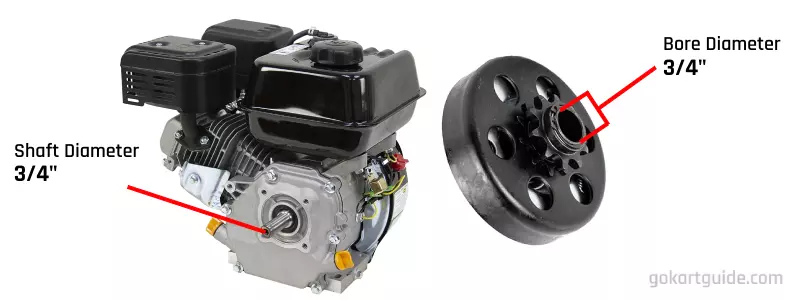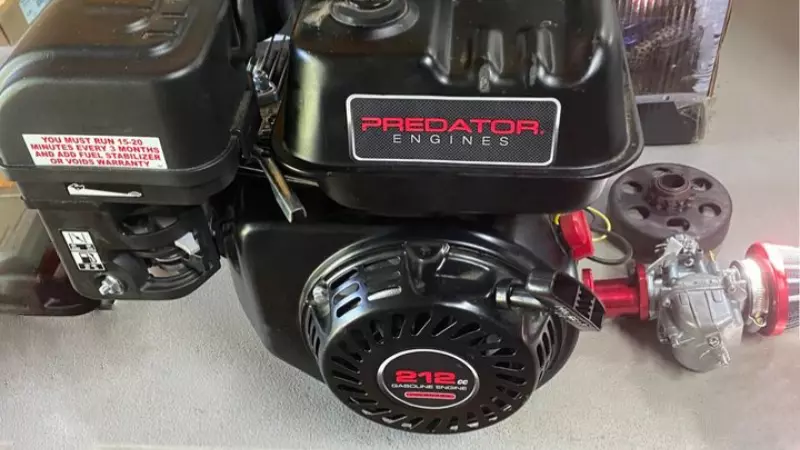A go-kart clutch is a mechanical device that engages power transmission from the engine to the rear axle. It’s attached to the crankshaft of the engine and is connected to the rear axle through a chain.
In this review, I will be sharing with you the best centrifugal clutches for your Predator 212 engine. Below the reviews, you’ll find an extensive buying guide that will talk about what aspects you should consider, so that you can make an informed purchase decision.
1. Teantech Go-Kart Clutch
The Teantech Go-Kart Clutch is the best clutch for Predator 212 engines, as it’s made of high-quality parts and contains a compatible #40/41/420 chain. While it comes with various bore diameter options, it’s important that you select the 3/4” variant.
This go-kart clutch features a 10-tooth sprocket and a height of 2.17” (55mm) and a diameter of 4.21” (107mm), making it a great clutch for a Predator 212 engine. It also has an engagement speed of 2,300 ± 300 rpm, which is fairly common.
Specification:
- Bore Diameter: 3/4″
- Sprocket Teeth: 10
- Clutch Height: 55mm (2.17″)
- Clutch Diameter: 107mm (4.21″)
Compatibility:
- Predator 212: Compatible
- Chain Size: #40/41/420
- Recommended HP: 2 – 6.5 hp
- Speed: 2300 ± 300 rpm
2. Tiot Go-Kart Clutch
The Tiot Go-Kart Clutch is another great choice for Predator engines, as it features a 3/4″ bore diameter which is compatible with the engine’s 3/4″ shaft diameter. This clutch also comes with a compatible chain, which means that you won’t need to source for one separately.
It’s 4.2” in diameter and 0.97” thick (without the sprocket). It also has an engagement range of 2,300 ± 300 rpm and a 10-tooth sprocket, making it an ideal choice for go-karts that are equipped with Predator 212 engines.
Specification:
- Bore Diameter: 3/4″
- Sprocket Teeth: 10
- Clutch Height: 55mm (2.17″)
- Clutch Diameter: 107mm (4.2″)
Compatibility:
- Predator 212: Compatible
- Chain Size: #40/41/420
- Recommended HP: 2 – 6.5 hp
- Speed: 2300 ± 300 rpm
3. LotFancy Go-Kart Clutch
Next in this list is the LotFancy Go-Kart Clutch. Similar to the other clutches mentioned in this list, it features a 10-tooth sprocket and a 3/4” bore diameter, making it a great choice for Predator 212 engines. Having a 10-tooth sprocket also means that it’s compatible with a #40, #41 or #420 chain.
However, take note that this clutch doesn’t come with a chain included, meaning that you’ll need to purchase it separately. As far as dimensions are concerned, it has an height of 2.17” (55mm) and an overall diameter of 4.21” (107mm).
Specification:
- Bore Diameter: 3/4″
- Sprocket Teeth: 10
- Clutch Height: 55mm (2.17″)
- Clutch Diameter: 107mm (4.2″)
Compatibility:
- Predator 212: Compatible
- Chain Size: #40/41/420
- Recommended HP: 2 – 6.5 hp
- Speed: 2300 ± 300 rpm
4. FDJ Go-Kart Clutch
The FDJ Go-Kart Clutch is another suitable pick for the Predator 212 engine. Having an engagement range of 2,300 ± 300 rpm (the same as the rest of the clutches on this list) and a recommended engine output of 2 – 6.5 hp, makes it a great pick.
Moreover, it also features a 3/4” bore diameter and a built-in keyway, making it convenient to install. It’s got an outside diameter of 4.75″, a clutch back to sprocket width of 2.5” and a total width of 3″, which is ideal. As this clutch is slightly larger than normal, it’s best to ensure that it fits.
Specification:
- Bore Diameter: 3/4″
- Sprocket Teeth: 10
- Clutch Height: 63.5mm (2.5″)
- Clutch Diameter: 121mm (4.75″)
Compatibility:
- Predator 212: Compatible
- Chain Size: #40/41/420
- Recommended HP: 2 – 6.5 hp
- Speed: 2300 ± 300 rpm
5. Motovecor Go-Kart Clutch
The Motovecor Go-Kart Clutch is also compatible with the Predator 212 engine, as it features a 3/4” bore and fits any #40, #41 and #420 chain, since it has a 10-tooth sprocket. It’s also got a similar engagement range.
This clutch starts engaging around 2,000 rpm and is fully engaged between 2,300 to 2,600 rpm, which makes it compatible with any engine that has a maximum output of 6.5 hp. The Predator 212 engine has 6.5 hp stock, so it’s a good choice.
Specification:
- Bore Diameter: 3/4″
- Sprocket Teeth: 10
- Clutch Height: 55mm (2.17″)
- Clutch Diameter: 107mm (4.2″)
Compatibility:
- Predator 212: Compatible
- Chain Size: #40/41/420
- Recommended HP: 2 – 6.5 hp
- Speed: 2300 ± 300 rpm
Buying Guide: Selecting the Best Clutch For Your Predator Engine
When looking for a clutch for your Predator 212 engine, it’s important that you consider various aspects such as the compatibility, bore diameter, chain size, sprocket teeth and engagement range. This section aims to provide you with as much relevant information as possible, to help you make an informed purchase decision.
Compatibility
I’ve created a table with the three most common centrifugal clutches that are available on the market. The clutches that are compatible with a Predator 212 engine have different bore diameters and chain size compatibility.
| 10T & 3/4" Clutch | 12T & 3/4" Clutch | 10T & 5/8" Clutch | |
|---|---|---|---|
| Type | Centrifugal Clutch | Centrifugal Clutch | Centrifugal Clutch |
| Bore Diameter | 3/4" | 3/4" | 5/8" |
| Sprocket | 10 Teeth | 12 Teeth | 10 Teeth |
| Chain Size | #40/41/420 | #35 | #35 |
| Engagement Range | 2,300 ± 300 rpm | 2,300 ± 300 rpm | 2,300 ± 300 rpm |
| Rear Tire Size | Less than 15" | Less than 15" | Less than 15" |
| Engine Output | Up to 6.5 hp | Up to 6.5 hp | Up to 6.5 hp |
| Compatibility | Yes Recommended | Yes Not recommended (small chain) | No Wrong bore size |
As you can see, the Predator 212cc engine has two compatible centrifugal clutch that can be used: the 10T & 3/4″ Clutch and the 12T & 3/4″ Clutch. However, I highly recommend the 10T & 3/4″ Clutch, as it’s compatible with larger and more heavy-duty chains.
Let’s explore the bore diameter and recommended chain size in a little more detail.
Bore Diameter
One of the most important things that you’ll need to take note of is the clutch bore diameter, as this has to be compatible with your Predator 212 engine.

In the image above, you’ll see that the bore of the clutch needs to be 3/4″ in order for it to be compatible with the Predator 212 engine. This is because the shaft diameter (diameter of the engine’s crankshaft) is also 3/4″ and the go-kart clutch slides on top of the crankshaft.
This also means that clutches which have other bore diameter sizes such as 5/8″ are not compatible with your Predator engine. Therefore, it’s important to look at the bore diameter carefully before deciding which clutch to purchase.
Chain Size
When looking at the Predator 212 go-kart clutch, you’ll have the options of a 3/4″ bore with a 10-tooth sprocket or a 12-tooth sprocket. The important thing to understand here a 10-tooth sprocket clutch supports #40, #41 and #420 chain, whereas the 12-tooth sprocket clutch supports a #35 chain.

As you can see from the illustration above the pitch of a #35 chain is relatively small at 3/8″. I don’t recommend #35 chains, although it’s possible to use them on go-karts. However, chances are that they may break under a too heavy load.
Instead, I would recommend that you opt for a clutch that is has 10 sprockets and supports a #40/41/420 chain. These chains have a 1/2″ pitch and are also larger in size. Therefore, you’ll be able to pick either a #40, #41 or #420 chain, which is more durable.
If you need more information on the various aspects of chain sizes, feel free to check out the go-kart chain size chart that I created.
Sprocket Teeth
As you’ll need to opt for a clutch with a 3/4″ bore diameter, you’ll have the choice of a 10-sprocket or 12-sprocket version. There are two main differences between both types of Predator clutches.
The 10-sprocket clutch is compatible with a #40/41/420 chain, which I highly recommend, while the 12-sprocket clutch is only compatible with a #35 chain.
Engagement Speed
You will also see that each clutch has a specific engagement range. The engagement range of a go-kart clutch the speed at which it engages. When the crankshaft of the Predator 212 engine reaches that speed (rpm), the friction material of the clutch makes contact with the outer drum.
Once it makes contact, it engages and enables the clutch to spin with the crankshaft, in order to transfer the rotational power from the engine to the rear axle, and ultimately to the wheels.
Most go-kart clutches that are compatible with Predator 212 engines have an engagement range of 2,300 ± 300 rpm, meaning somewhere between 2,000 and 2,600 rpm.
Engine Output
The output engine of a go-kart determines its power and ultimately how fast your go-kart is. The Predator 212 engine has an output of 6.5 hp. Most commercially available centrifugal clutches are suitable for up to 8 hp, which make them suitable for the Predator 212 engine.
If you have installed any type of Predator engine mods or upgraded any components that increase the overall output of your engine above 8 hp, then I recommend that you either opt for a heavy-duty clutch or a racing clutch.
This is because an overpowered engine may cause excessive wear on a regular clutch causing it to fail over the long term.
Tire Size
You’ll also notice that each clutch will usually have a recommended maximum tire size, which is about 15” or less. Larger tires aren’t compatible with these types of clutches and it’s best to ensure that your tire size doesn’t exceed this diameter limit.
Frequently Asked Questions
If you’re looking for the best go-kart clutch for your Predator 212 engine and still have some questions, then you are at the right place. I’ve compiled a list of the most frequently asked questions on this topic. If you have any questions that aren’t on this list, feel free to get in touch and I’ll be happy to address them.
What Type of Clutch is Best For a Predator 212 Engine
There are various types of go-kart clutches that work differently, but have the same purpose and function.
- Centrifugal Clutches
- Hydraulic Clutches
- Electromagnetic Clutches
The most commonly used clutch is a centrifugal clutch, which is also featured in the review section. I recommend centrifugal clutches over any other type, as they are a lot more affordable and require less maintenance than electromagnetic and hydraulic clutches.
Is a Clutch or a Torque Converter Better For a Predator Engine?
It really depends on what type of go-kart you have. If you have a predator engine installed on your off-road go-kart and you do a lot of off-road racing, then a torque converter may be preferred.
On the other hand, a go-kart clutch is more common on homemade or racing go-karts. Check out my guide on go-kart clutches vs torque converters for more information on this topic.






